Impact of COVID-19 on Business Performance: Data Analysis Report
VerifiedAdded on 2022/12/17
|9
|2159
|25
Report
AI Summary
This report examines the profound impact of the COVID-19 pandemic on business performance, drawing on data analysis to assess the effects on employee behavior and organizational strategies. The study utilizes quantitative analysis, including demographic variables, reliability tests, and regression analysis, to evaluate the influence of COVID-19 on various aspects of business operations. Key findings reveal significant shifts in employee behavior, communication methods, and daily routines due to the pandemic and the implementation of "new normal" protocols. The report discusses the challenges faced by businesses in adapting to telework, social distancing, and hygiene measures, and it highlights the importance of employee responses to change. The analysis concludes that the pandemic has negatively impacted manufacturing performance, emphasizing the need for businesses to support employees in adjusting to these changes. It also underscores the importance of employee well-being and the necessity for leadership to effectively manage and support employees through these transitions. The report provides valuable insights into the lasting effects of the pandemic on the business environment.
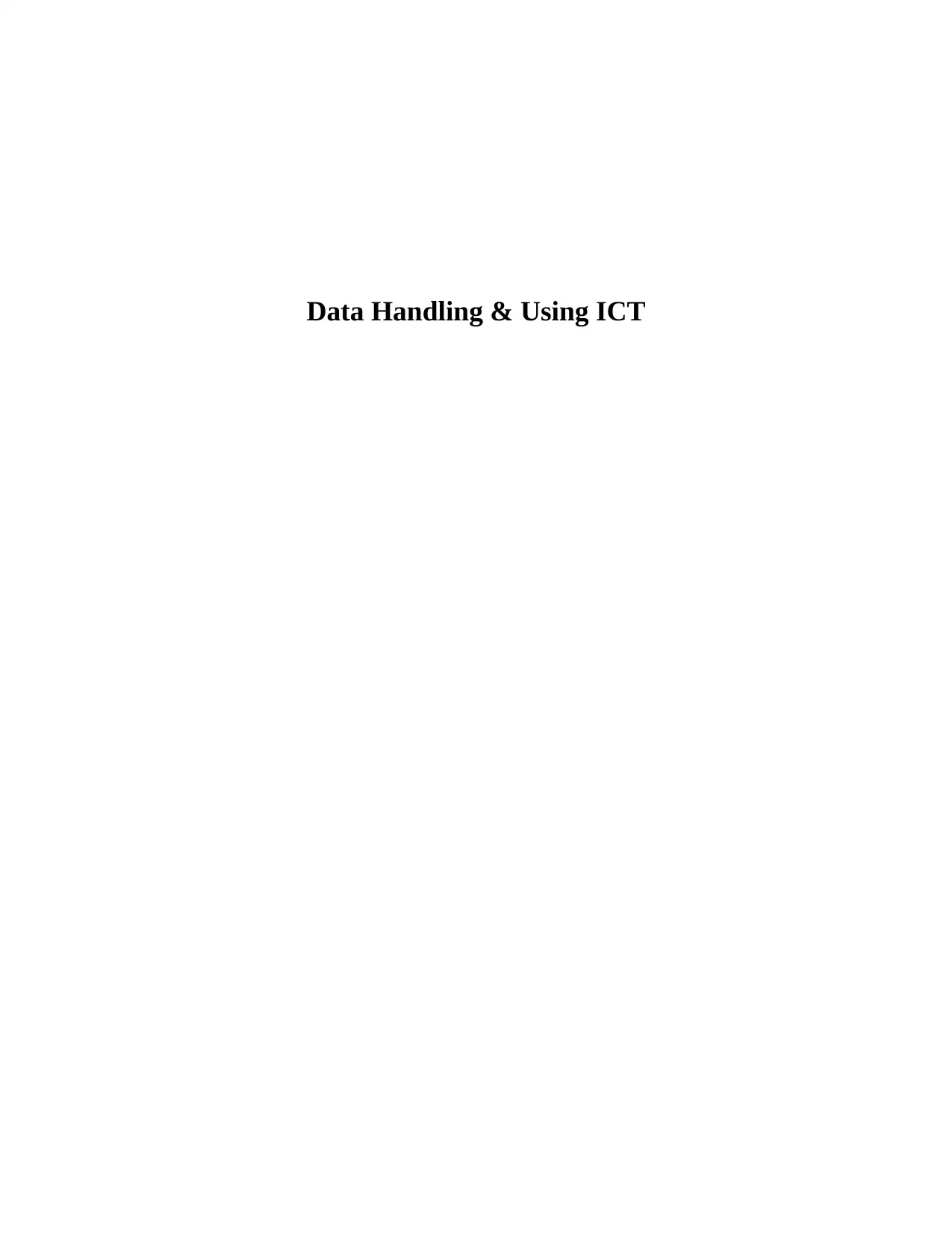
Data Handling & Using ICT
Paraphrase This Document
Need a fresh take? Get an instant paraphrase of this document with our AI Paraphraser
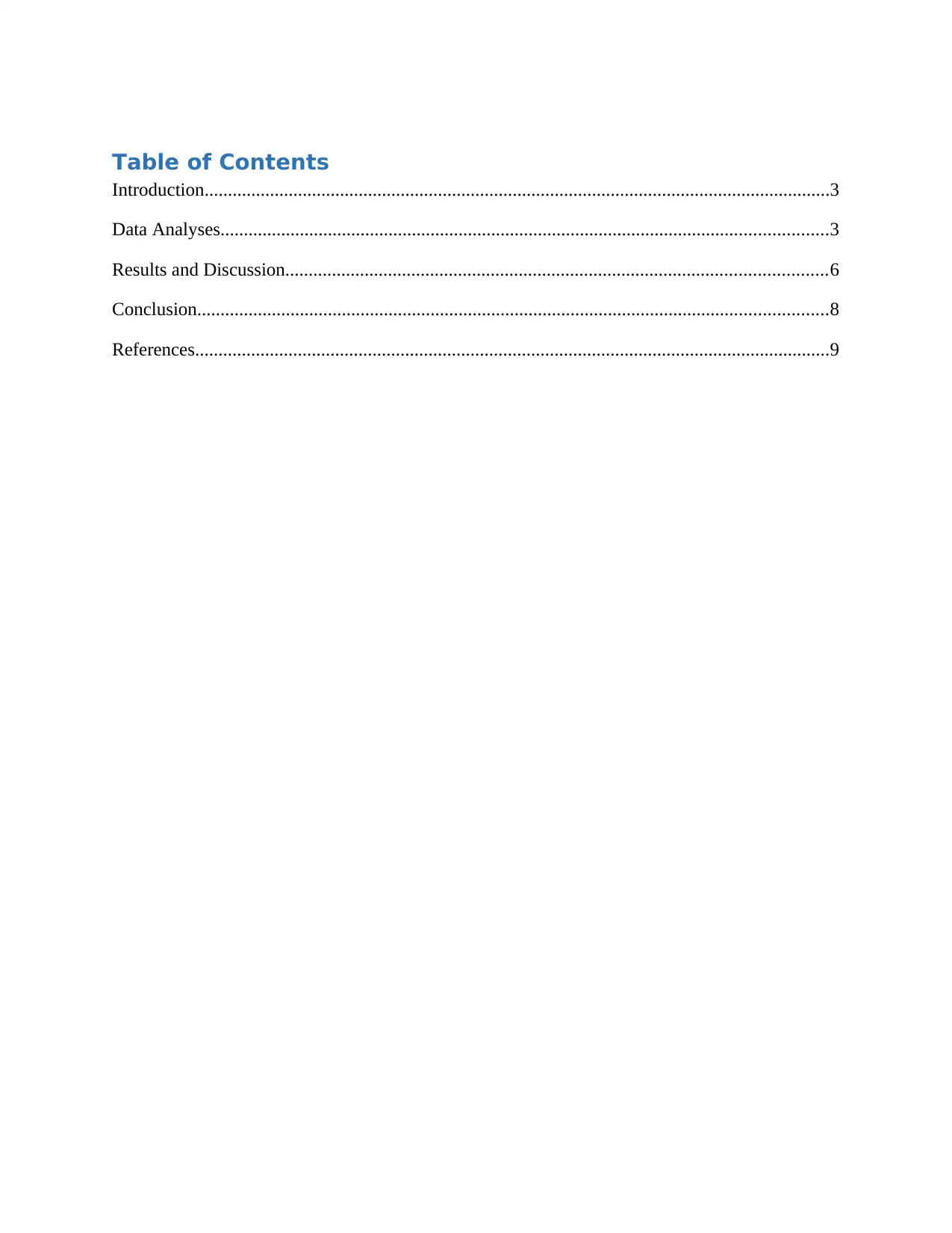
Table of Contents
Introduction......................................................................................................................................3
Data Analyses..................................................................................................................................3
Results and Discussion....................................................................................................................6
Conclusion.......................................................................................................................................8
References........................................................................................................................................9
Introduction......................................................................................................................................3
Data Analyses..................................................................................................................................3
Results and Discussion....................................................................................................................6
Conclusion.......................................................................................................................................8
References........................................................................................................................................9
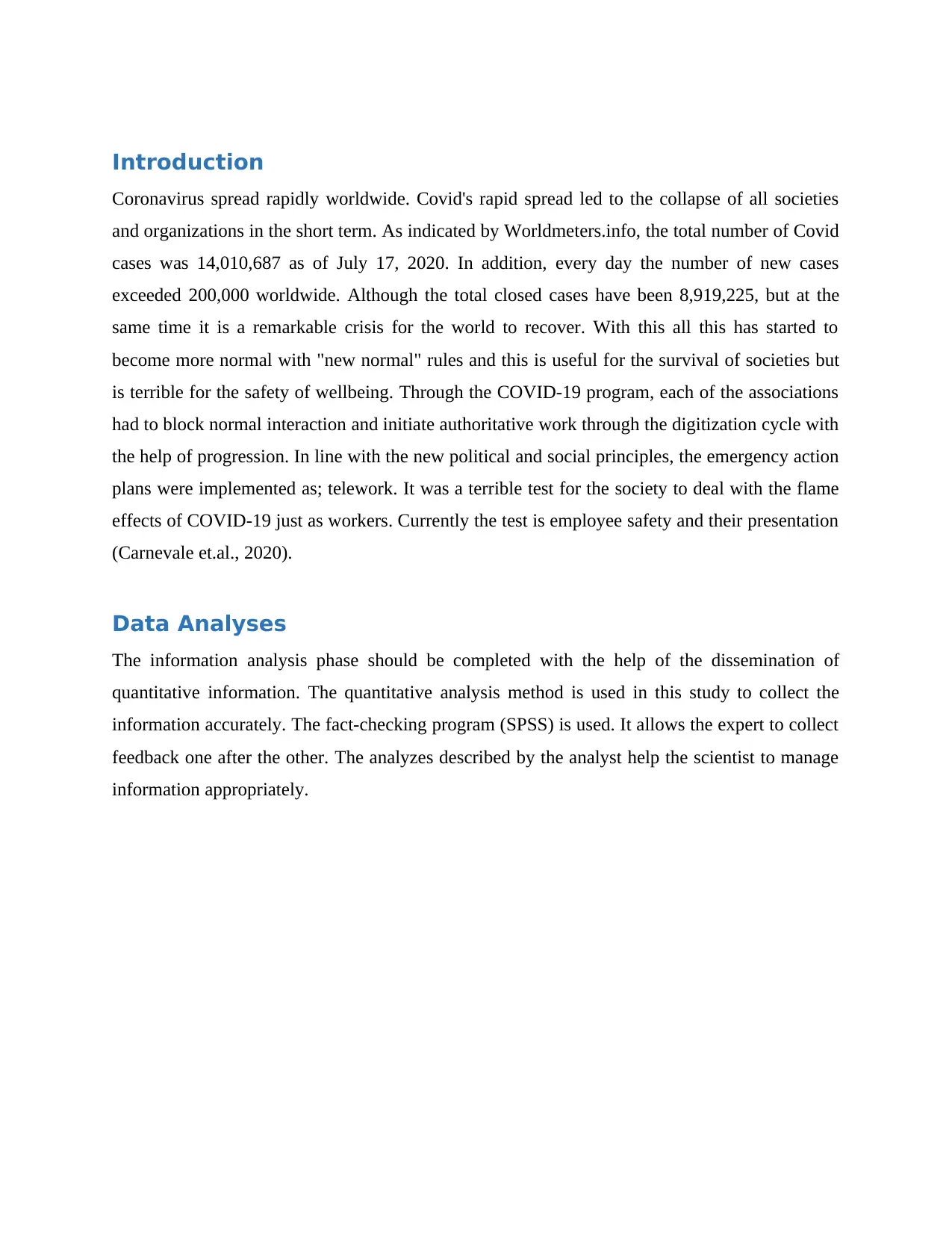
Introduction
Coronavirus spread rapidly worldwide. Covid's rapid spread led to the collapse of all societies
and organizations in the short term. As indicated by Worldmeters.info, the total number of Covid
cases was 14,010,687 as of July 17, 2020. In addition, every day the number of new cases
exceeded 200,000 worldwide. Although the total closed cases have been 8,919,225, but at the
same time it is a remarkable crisis for the world to recover. With this all this has started to
become more normal with "new normal" rules and this is useful for the survival of societies but
is terrible for the safety of wellbeing. Through the COVID-19 program, each of the associations
had to block normal interaction and initiate authoritative work through the digitization cycle with
the help of progression. In line with the new political and social principles, the emergency action
plans were implemented as; telework. It was a terrible test for the society to deal with the flame
effects of COVID-19 just as workers. Currently the test is employee safety and their presentation
(Carnevale et.al., 2020).
Data Analyses
The information analysis phase should be completed with the help of the dissemination of
quantitative information. The quantitative analysis method is used in this study to collect the
information accurately. The fact-checking program (SPSS) is used. It allows the expert to collect
feedback one after the other. The analyzes described by the analyst help the scientist to manage
information appropriately.
Coronavirus spread rapidly worldwide. Covid's rapid spread led to the collapse of all societies
and organizations in the short term. As indicated by Worldmeters.info, the total number of Covid
cases was 14,010,687 as of July 17, 2020. In addition, every day the number of new cases
exceeded 200,000 worldwide. Although the total closed cases have been 8,919,225, but at the
same time it is a remarkable crisis for the world to recover. With this all this has started to
become more normal with "new normal" rules and this is useful for the survival of societies but
is terrible for the safety of wellbeing. Through the COVID-19 program, each of the associations
had to block normal interaction and initiate authoritative work through the digitization cycle with
the help of progression. In line with the new political and social principles, the emergency action
plans were implemented as; telework. It was a terrible test for the society to deal with the flame
effects of COVID-19 just as workers. Currently the test is employee safety and their presentation
(Carnevale et.al., 2020).
Data Analyses
The information analysis phase should be completed with the help of the dissemination of
quantitative information. The quantitative analysis method is used in this study to collect the
information accurately. The fact-checking program (SPSS) is used. It allows the expert to collect
feedback one after the other. The analyzes described by the analyst help the scientist to manage
information appropriately.
⊘ This is a preview!⊘
Do you want full access?
Subscribe today to unlock all pages.

Trusted by 1+ million students worldwide
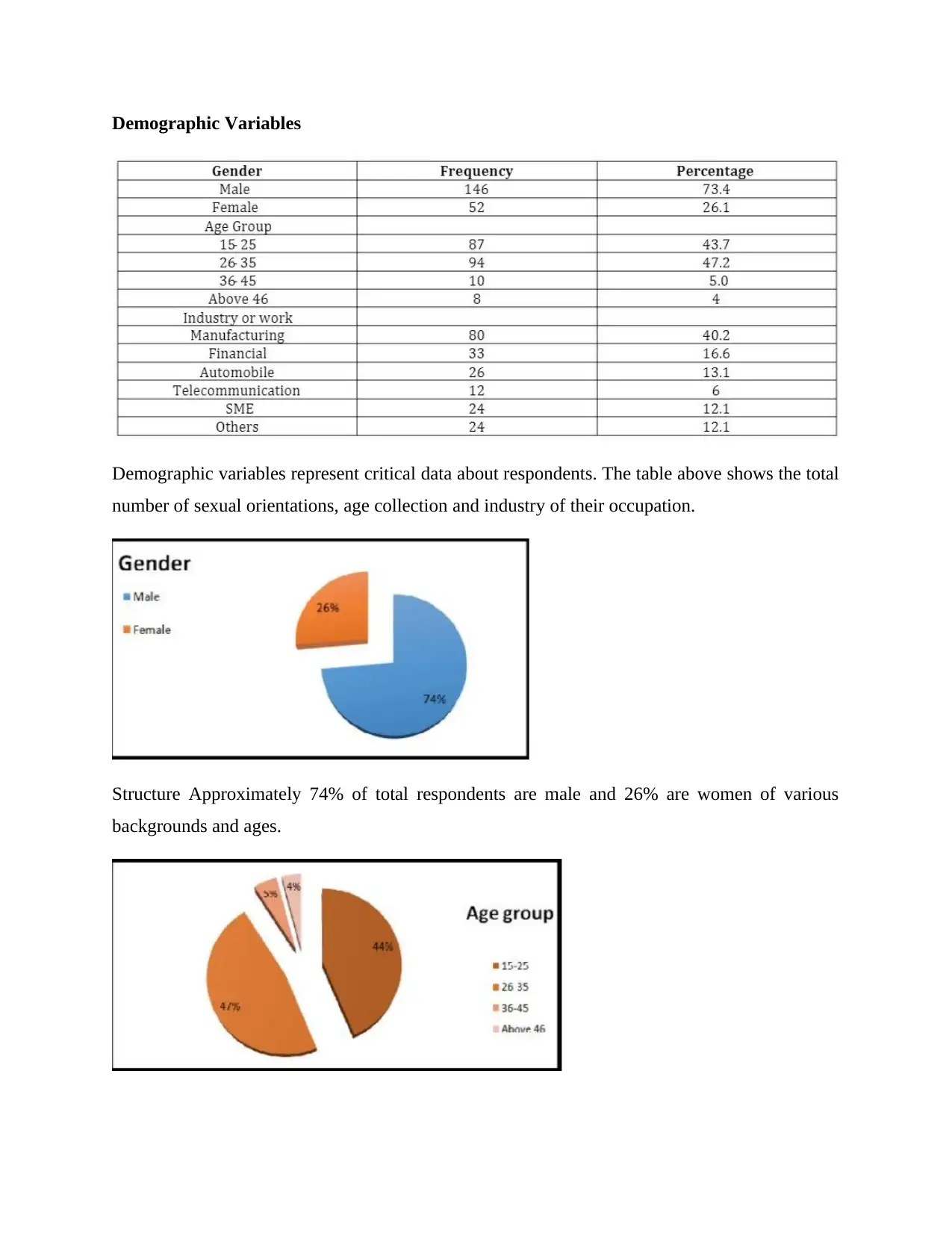
Demographic Variables
Demographic variables represent critical data about respondents. The table above shows the total
number of sexual orientations, age collection and industry of their occupation.
Structure Approximately 74% of total respondents are male and 26% are women of various
backgrounds and ages.
Demographic variables represent critical data about respondents. The table above shows the total
number of sexual orientations, age collection and industry of their occupation.
Structure Approximately 74% of total respondents are male and 26% are women of various
backgrounds and ages.
Paraphrase This Document
Need a fresh take? Get an instant paraphrase of this document with our AI Paraphraser
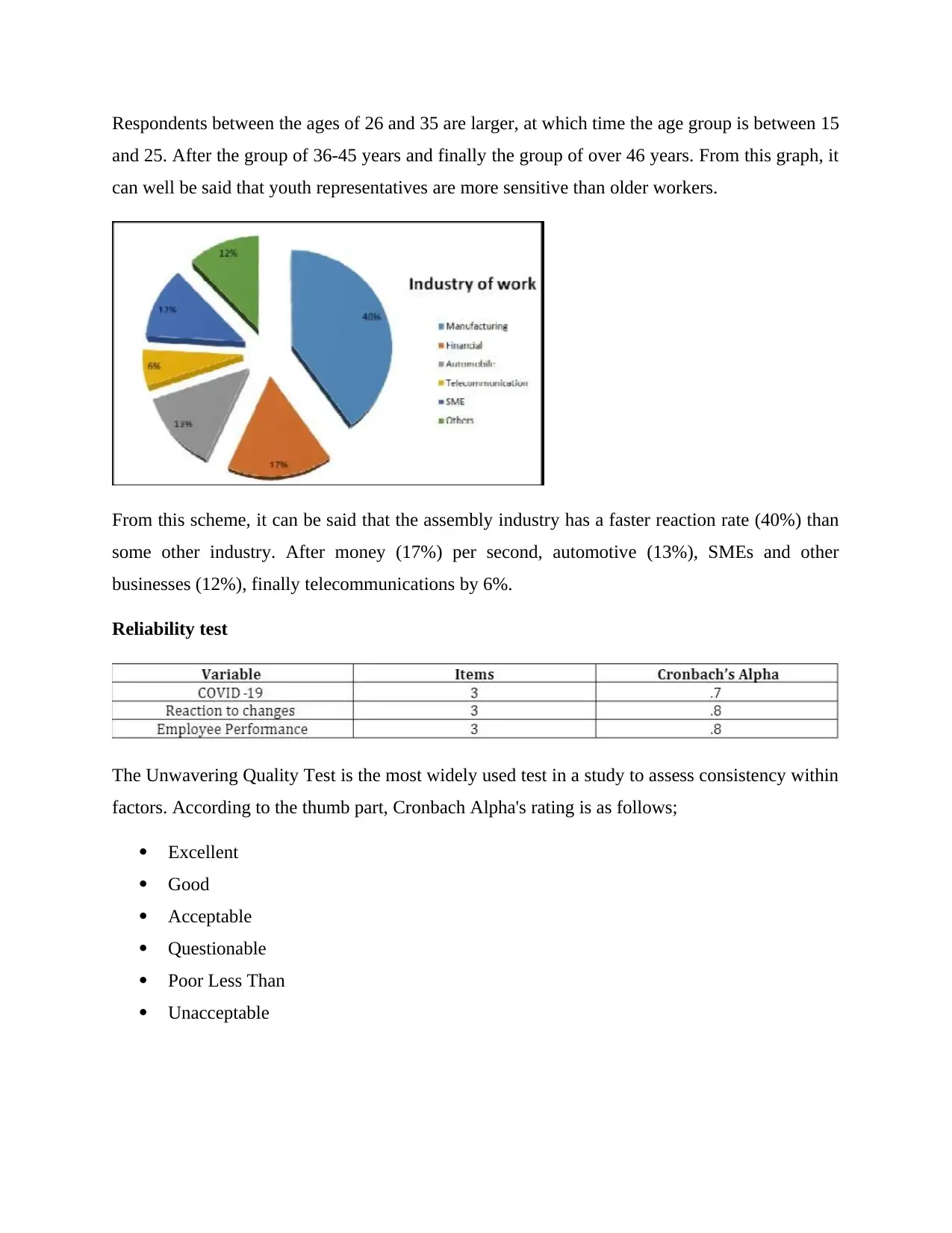
Respondents between the ages of 26 and 35 are larger, at which time the age group is between 15
and 25. After the group of 36-45 years and finally the group of over 46 years. From this graph, it
can well be said that youth representatives are more sensitive than older workers.
From this scheme, it can be said that the assembly industry has a faster reaction rate (40%) than
some other industry. After money (17%) per second, automotive (13%), SMEs and other
businesses (12%), finally telecommunications by 6%.
Reliability test
The Unwavering Quality Test is the most widely used test in a study to assess consistency within
factors. According to the thumb part, Cronbach Alpha's rating is as follows;
Excellent
Good
Acceptable
Questionable
Poor Less Than
Unacceptable
and 25. After the group of 36-45 years and finally the group of over 46 years. From this graph, it
can well be said that youth representatives are more sensitive than older workers.
From this scheme, it can be said that the assembly industry has a faster reaction rate (40%) than
some other industry. After money (17%) per second, automotive (13%), SMEs and other
businesses (12%), finally telecommunications by 6%.
Reliability test
The Unwavering Quality Test is the most widely used test in a study to assess consistency within
factors. According to the thumb part, Cronbach Alpha's rating is as follows;
Excellent
Good
Acceptable
Questionable
Poor Less Than
Unacceptable
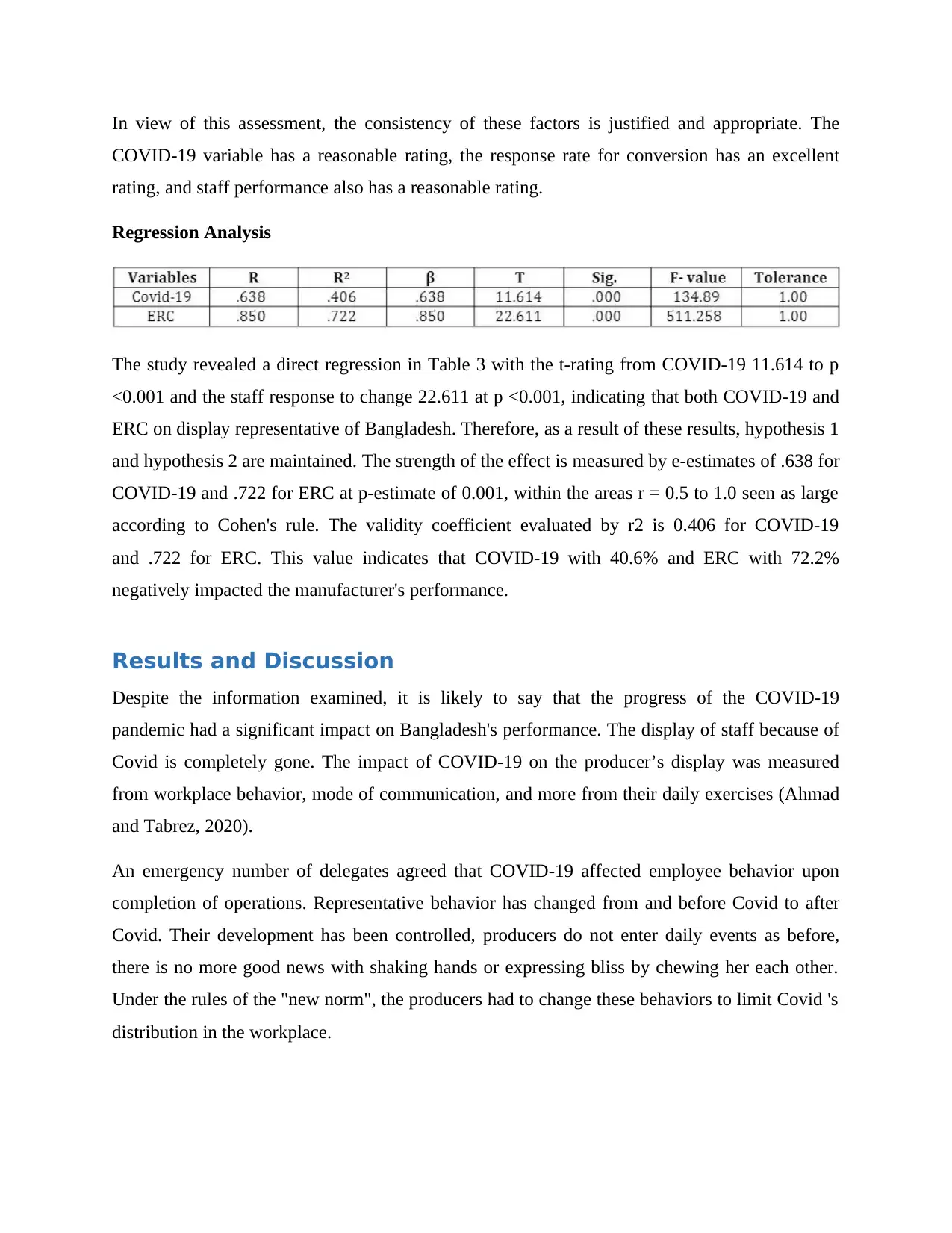
In view of this assessment, the consistency of these factors is justified and appropriate. The
COVID-19 variable has a reasonable rating, the response rate for conversion has an excellent
rating, and staff performance also has a reasonable rating.
Regression Analysis
The study revealed a direct regression in Table 3 with the t-rating from COVID-19 11.614 to p
<0.001 and the staff response to change 22.611 at p <0.001, indicating that both COVID-19 and
ERC on display representative of Bangladesh. Therefore, as a result of these results, hypothesis 1
and hypothesis 2 are maintained. The strength of the effect is measured by e-estimates of .638 for
COVID-19 and .722 for ERC at p-estimate of 0.001, within the areas r = 0.5 to 1.0 seen as large
according to Cohen's rule. The validity coefficient evaluated by r2 is 0.406 for COVID-19
and .722 for ERC. This value indicates that COVID-19 with 40.6% and ERC with 72.2%
negatively impacted the manufacturer's performance.
Results and Discussion
Despite the information examined, it is likely to say that the progress of the COVID-19
pandemic had a significant impact on Bangladesh's performance. The display of staff because of
Covid is completely gone. The impact of COVID-19 on the producer’s display was measured
from workplace behavior, mode of communication, and more from their daily exercises (Ahmad
and Tabrez, 2020).
An emergency number of delegates agreed that COVID-19 affected employee behavior upon
completion of operations. Representative behavior has changed from and before Covid to after
Covid. Their development has been controlled, producers do not enter daily events as before,
there is no more good news with shaking hands or expressing bliss by chewing her each other.
Under the rules of the "new norm", the producers had to change these behaviors to limit Covid 's
distribution in the workplace.
COVID-19 variable has a reasonable rating, the response rate for conversion has an excellent
rating, and staff performance also has a reasonable rating.
Regression Analysis
The study revealed a direct regression in Table 3 with the t-rating from COVID-19 11.614 to p
<0.001 and the staff response to change 22.611 at p <0.001, indicating that both COVID-19 and
ERC on display representative of Bangladesh. Therefore, as a result of these results, hypothesis 1
and hypothesis 2 are maintained. The strength of the effect is measured by e-estimates of .638 for
COVID-19 and .722 for ERC at p-estimate of 0.001, within the areas r = 0.5 to 1.0 seen as large
according to Cohen's rule. The validity coefficient evaluated by r2 is 0.406 for COVID-19
and .722 for ERC. This value indicates that COVID-19 with 40.6% and ERC with 72.2%
negatively impacted the manufacturer's performance.
Results and Discussion
Despite the information examined, it is likely to say that the progress of the COVID-19
pandemic had a significant impact on Bangladesh's performance. The display of staff because of
Covid is completely gone. The impact of COVID-19 on the producer’s display was measured
from workplace behavior, mode of communication, and more from their daily exercises (Ahmad
and Tabrez, 2020).
An emergency number of delegates agreed that COVID-19 affected employee behavior upon
completion of operations. Representative behavior has changed from and before Covid to after
Covid. Their development has been controlled, producers do not enter daily events as before,
there is no more good news with shaking hands or expressing bliss by chewing her each other.
Under the rules of the "new norm", the producers had to change these behaviors to limit Covid 's
distribution in the workplace.
⊘ This is a preview!⊘
Do you want full access?
Subscribe today to unlock all pages.

Trusted by 1+ million students worldwide
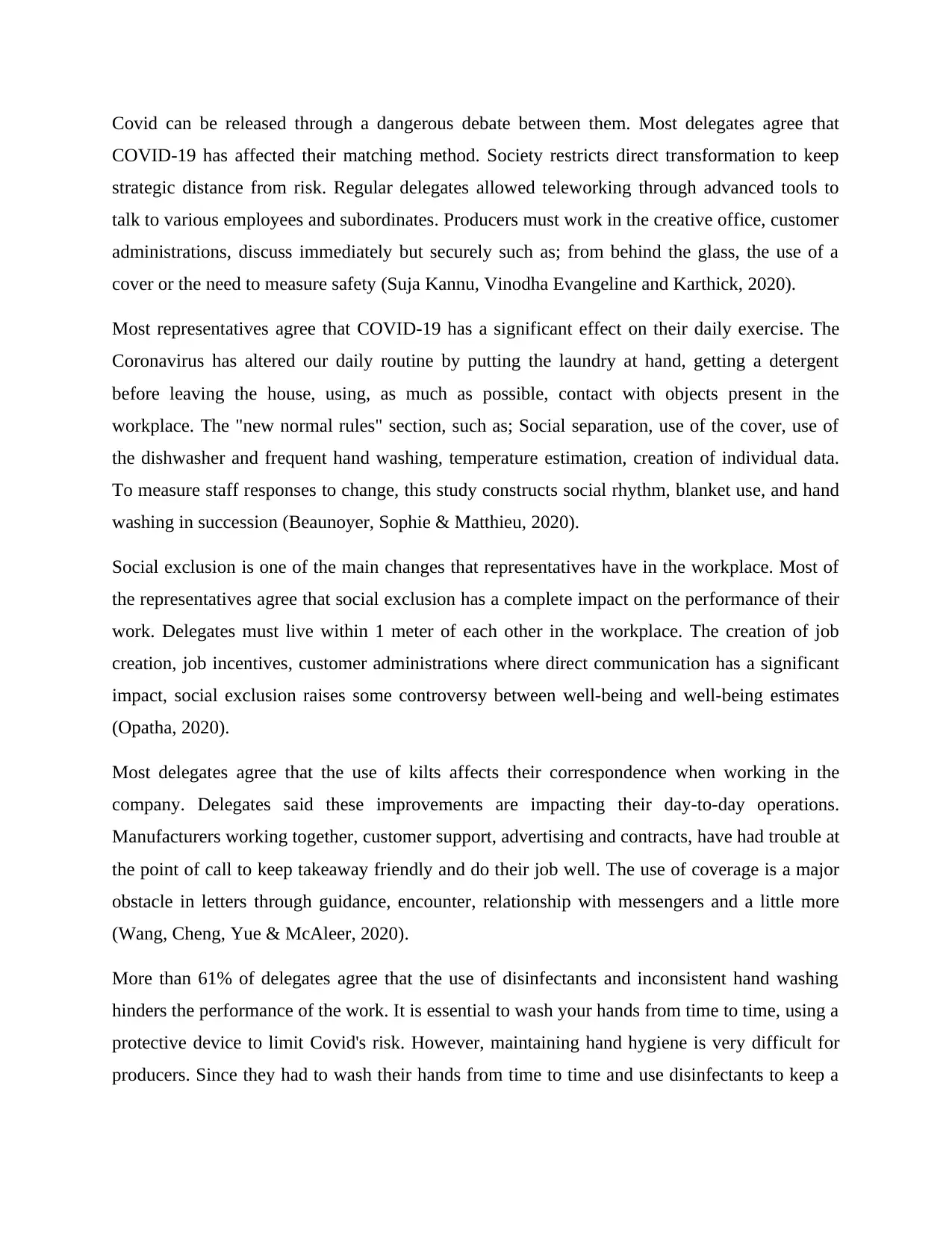
Covid can be released through a dangerous debate between them. Most delegates agree that
COVID-19 has affected their matching method. Society restricts direct transformation to keep
strategic distance from risk. Regular delegates allowed teleworking through advanced tools to
talk to various employees and subordinates. Producers must work in the creative office, customer
administrations, discuss immediately but securely such as; from behind the glass, the use of a
cover or the need to measure safety (Suja Kannu, Vinodha Evangeline and Karthick, 2020).
Most representatives agree that COVID-19 has a significant effect on their daily exercise. The
Coronavirus has altered our daily routine by putting the laundry at hand, getting a detergent
before leaving the house, using, as much as possible, contact with objects present in the
workplace. The "new normal rules" section, such as; Social separation, use of the cover, use of
the dishwasher and frequent hand washing, temperature estimation, creation of individual data.
To measure staff responses to change, this study constructs social rhythm, blanket use, and hand
washing in succession (Beaunoyer, Sophie & Matthieu, 2020).
Social exclusion is one of the main changes that representatives have in the workplace. Most of
the representatives agree that social exclusion has a complete impact on the performance of their
work. Delegates must live within 1 meter of each other in the workplace. The creation of job
creation, job incentives, customer administrations where direct communication has a significant
impact, social exclusion raises some controversy between well-being and well-being estimates
(Opatha, 2020).
Most delegates agree that the use of kilts affects their correspondence when working in the
company. Delegates said these improvements are impacting their day-to-day operations.
Manufacturers working together, customer support, advertising and contracts, have had trouble at
the point of call to keep takeaway friendly and do their job well. The use of coverage is a major
obstacle in letters through guidance, encounter, relationship with messengers and a little more
(Wang, Cheng, Yue & McAleer, 2020).
More than 61% of delegates agree that the use of disinfectants and inconsistent hand washing
hinders the performance of the work. It is essential to wash your hands from time to time, using a
protective device to limit Covid's risk. However, maintaining hand hygiene is very difficult for
producers. Since they had to wash their hands from time to time and use disinfectants to keep a
COVID-19 has affected their matching method. Society restricts direct transformation to keep
strategic distance from risk. Regular delegates allowed teleworking through advanced tools to
talk to various employees and subordinates. Producers must work in the creative office, customer
administrations, discuss immediately but securely such as; from behind the glass, the use of a
cover or the need to measure safety (Suja Kannu, Vinodha Evangeline and Karthick, 2020).
Most representatives agree that COVID-19 has a significant effect on their daily exercise. The
Coronavirus has altered our daily routine by putting the laundry at hand, getting a detergent
before leaving the house, using, as much as possible, contact with objects present in the
workplace. The "new normal rules" section, such as; Social separation, use of the cover, use of
the dishwasher and frequent hand washing, temperature estimation, creation of individual data.
To measure staff responses to change, this study constructs social rhythm, blanket use, and hand
washing in succession (Beaunoyer, Sophie & Matthieu, 2020).
Social exclusion is one of the main changes that representatives have in the workplace. Most of
the representatives agree that social exclusion has a complete impact on the performance of their
work. Delegates must live within 1 meter of each other in the workplace. The creation of job
creation, job incentives, customer administrations where direct communication has a significant
impact, social exclusion raises some controversy between well-being and well-being estimates
(Opatha, 2020).
Most delegates agree that the use of kilts affects their correspondence when working in the
company. Delegates said these improvements are impacting their day-to-day operations.
Manufacturers working together, customer support, advertising and contracts, have had trouble at
the point of call to keep takeaway friendly and do their job well. The use of coverage is a major
obstacle in letters through guidance, encounter, relationship with messengers and a little more
(Wang, Cheng, Yue & McAleer, 2020).
More than 61% of delegates agree that the use of disinfectants and inconsistent hand washing
hinders the performance of the work. It is essential to wash your hands from time to time, using a
protective device to limit Covid's risk. However, maintaining hand hygiene is very difficult for
producers. Since they had to wash their hands from time to time and use disinfectants to keep a
Paraphrase This Document
Need a fresh take? Get an instant paraphrase of this document with our AI Paraphraser
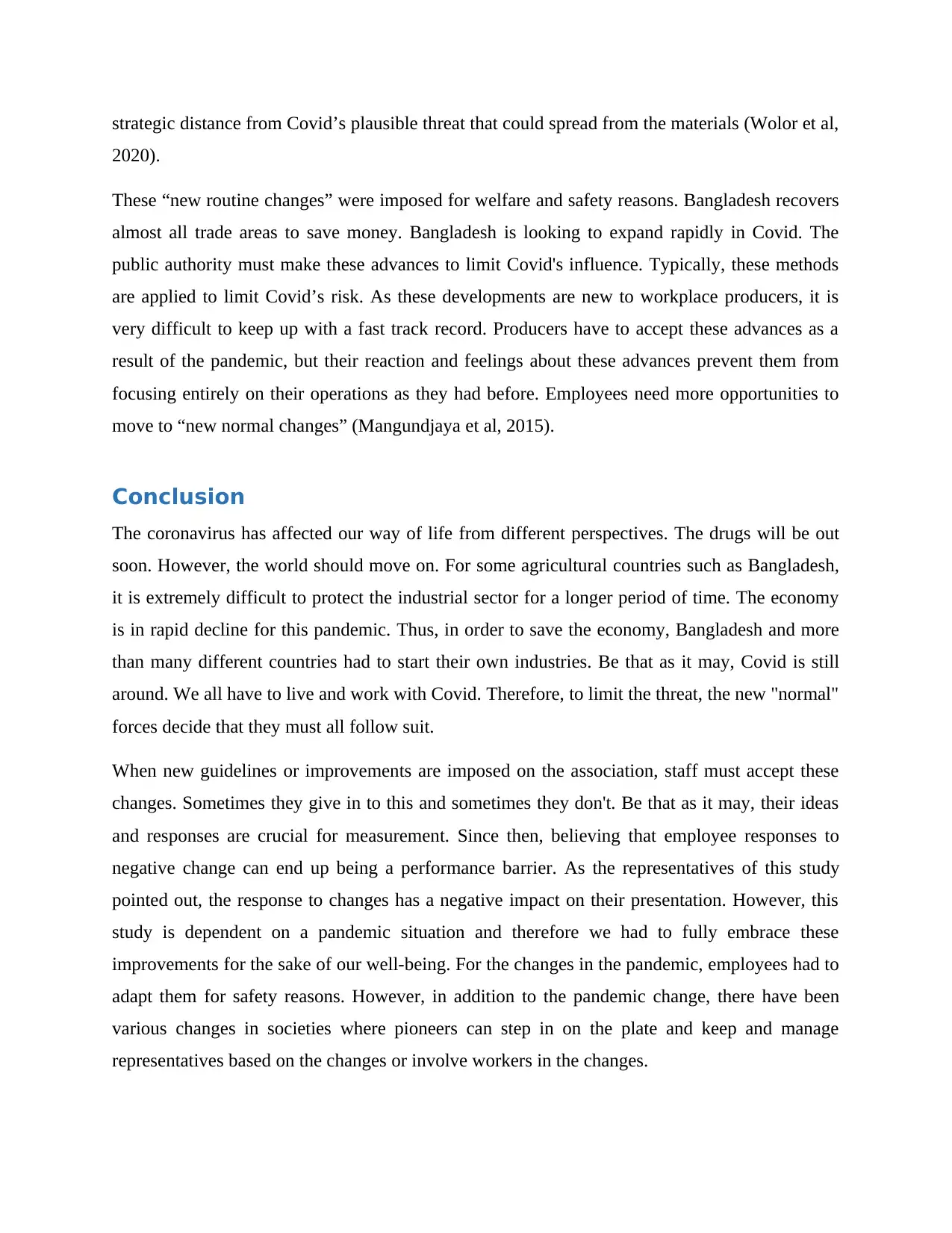
strategic distance from Covid’s plausible threat that could spread from the materials (Wolor et al,
2020).
These “new routine changes” were imposed for welfare and safety reasons. Bangladesh recovers
almost all trade areas to save money. Bangladesh is looking to expand rapidly in Covid. The
public authority must make these advances to limit Covid's influence. Typically, these methods
are applied to limit Covid’s risk. As these developments are new to workplace producers, it is
very difficult to keep up with a fast track record. Producers have to accept these advances as a
result of the pandemic, but their reaction and feelings about these advances prevent them from
focusing entirely on their operations as they had before. Employees need more opportunities to
move to “new normal changes” (Mangundjaya et al, 2015).
Conclusion
The coronavirus has affected our way of life from different perspectives. The drugs will be out
soon. However, the world should move on. For some agricultural countries such as Bangladesh,
it is extremely difficult to protect the industrial sector for a longer period of time. The economy
is in rapid decline for this pandemic. Thus, in order to save the economy, Bangladesh and more
than many different countries had to start their own industries. Be that as it may, Covid is still
around. We all have to live and work with Covid. Therefore, to limit the threat, the new "normal"
forces decide that they must all follow suit.
When new guidelines or improvements are imposed on the association, staff must accept these
changes. Sometimes they give in to this and sometimes they don't. Be that as it may, their ideas
and responses are crucial for measurement. Since then, believing that employee responses to
negative change can end up being a performance barrier. As the representatives of this study
pointed out, the response to changes has a negative impact on their presentation. However, this
study is dependent on a pandemic situation and therefore we had to fully embrace these
improvements for the sake of our well-being. For the changes in the pandemic, employees had to
adapt them for safety reasons. However, in addition to the pandemic change, there have been
various changes in societies where pioneers can step in on the plate and keep and manage
representatives based on the changes or involve workers in the changes.
2020).
These “new routine changes” were imposed for welfare and safety reasons. Bangladesh recovers
almost all trade areas to save money. Bangladesh is looking to expand rapidly in Covid. The
public authority must make these advances to limit Covid's influence. Typically, these methods
are applied to limit Covid’s risk. As these developments are new to workplace producers, it is
very difficult to keep up with a fast track record. Producers have to accept these advances as a
result of the pandemic, but their reaction and feelings about these advances prevent them from
focusing entirely on their operations as they had before. Employees need more opportunities to
move to “new normal changes” (Mangundjaya et al, 2015).
Conclusion
The coronavirus has affected our way of life from different perspectives. The drugs will be out
soon. However, the world should move on. For some agricultural countries such as Bangladesh,
it is extremely difficult to protect the industrial sector for a longer period of time. The economy
is in rapid decline for this pandemic. Thus, in order to save the economy, Bangladesh and more
than many different countries had to start their own industries. Be that as it may, Covid is still
around. We all have to live and work with Covid. Therefore, to limit the threat, the new "normal"
forces decide that they must all follow suit.
When new guidelines or improvements are imposed on the association, staff must accept these
changes. Sometimes they give in to this and sometimes they don't. Be that as it may, their ideas
and responses are crucial for measurement. Since then, believing that employee responses to
negative change can end up being a performance barrier. As the representatives of this study
pointed out, the response to changes has a negative impact on their presentation. However, this
study is dependent on a pandemic situation and therefore we had to fully embrace these
improvements for the sake of our well-being. For the changes in the pandemic, employees had to
adapt them for safety reasons. However, in addition to the pandemic change, there have been
various changes in societies where pioneers can step in on the plate and keep and manage
representatives based on the changes or involve workers in the changes.
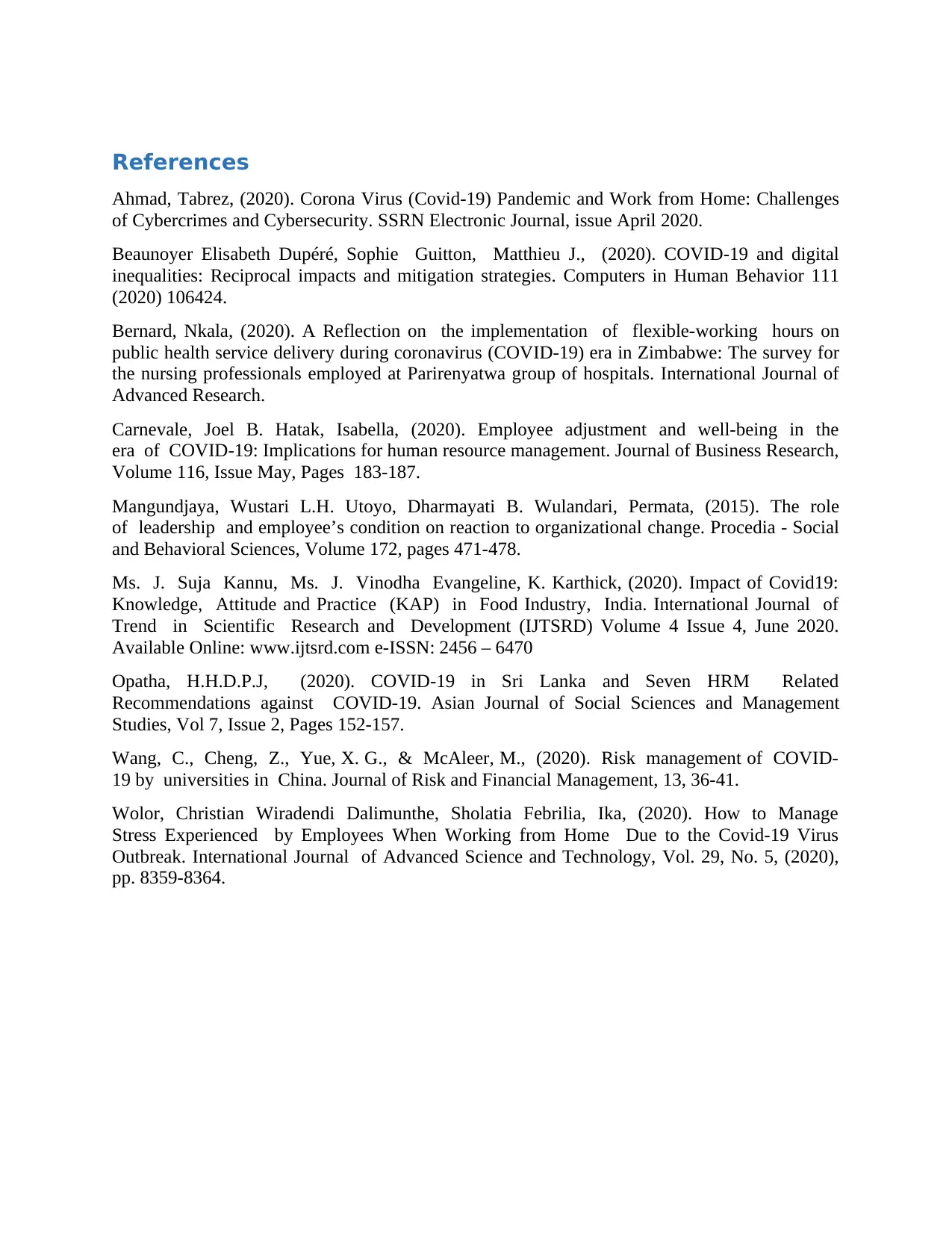
References
Ahmad, Tabrez, (2020). Corona Virus (Covid-19) Pandemic and Work from Home: Challenges
of Cybercrimes and Cybersecurity. SSRN Electronic Journal, issue April 2020.
Beaunoyer Elisabeth Dupéré, Sophie Guitton, Matthieu J., (2020). COVID-19 and digital
inequalities: Reciprocal impacts and mitigation strategies. Computers in Human Behavior 111
(2020) 106424.
Bernard, Nkala, (2020). A Reflection on the implementation of flexible-working hours on
public health service delivery during coronavirus (COVID-19) era in Zimbabwe: The survey for
the nursing professionals employed at Parirenyatwa group of hospitals. International Journal of
Advanced Research.
Carnevale, Joel B. Hatak, Isabella, (2020). Employee adjustment and well-being in the
era of COVID-19: Implications for human resource management. Journal of Business Research,
Volume 116, Issue May, Pages 183-187.
Mangundjaya, Wustari L.H. Utoyo, Dharmayati B. Wulandari, Permata, (2015). The role
of leadership and employee’s condition on reaction to organizational change. Procedia - Social
and Behavioral Sciences, Volume 172, pages 471-478.
Ms. J. Suja Kannu, Ms. J. Vinodha Evangeline, K. Karthick, (2020). Impact of Covid19:
Knowledge, Attitude and Practice (KAP) in Food Industry, India. International Journal of
Trend in Scientific Research and Development (IJTSRD) Volume 4 Issue 4, June 2020.
Available Online: www.ijtsrd.com e-ISSN: 2456 – 6470
Opatha, H.H.D.P.J, (2020). COVID-19 in Sri Lanka and Seven HRM Related
Recommendations against COVID-19. Asian Journal of Social Sciences and Management
Studies, Vol 7, Issue 2, Pages 152-157.
Wang, C., Cheng, Z., Yue, X. G., & McAleer, M., (2020). Risk management of COVID-
19 by universities in China. Journal of Risk and Financial Management, 13, 36-41.
Wolor, Christian Wiradendi Dalimunthe, Sholatia Febrilia, Ika, (2020). How to Manage
Stress Experienced by Employees When Working from Home Due to the Covid-19 Virus
Outbreak. International Journal of Advanced Science and Technology, Vol. 29, No. 5, (2020),
pp. 8359-8364.
Ahmad, Tabrez, (2020). Corona Virus (Covid-19) Pandemic and Work from Home: Challenges
of Cybercrimes and Cybersecurity. SSRN Electronic Journal, issue April 2020.
Beaunoyer Elisabeth Dupéré, Sophie Guitton, Matthieu J., (2020). COVID-19 and digital
inequalities: Reciprocal impacts and mitigation strategies. Computers in Human Behavior 111
(2020) 106424.
Bernard, Nkala, (2020). A Reflection on the implementation of flexible-working hours on
public health service delivery during coronavirus (COVID-19) era in Zimbabwe: The survey for
the nursing professionals employed at Parirenyatwa group of hospitals. International Journal of
Advanced Research.
Carnevale, Joel B. Hatak, Isabella, (2020). Employee adjustment and well-being in the
era of COVID-19: Implications for human resource management. Journal of Business Research,
Volume 116, Issue May, Pages 183-187.
Mangundjaya, Wustari L.H. Utoyo, Dharmayati B. Wulandari, Permata, (2015). The role
of leadership and employee’s condition on reaction to organizational change. Procedia - Social
and Behavioral Sciences, Volume 172, pages 471-478.
Ms. J. Suja Kannu, Ms. J. Vinodha Evangeline, K. Karthick, (2020). Impact of Covid19:
Knowledge, Attitude and Practice (KAP) in Food Industry, India. International Journal of
Trend in Scientific Research and Development (IJTSRD) Volume 4 Issue 4, June 2020.
Available Online: www.ijtsrd.com e-ISSN: 2456 – 6470
Opatha, H.H.D.P.J, (2020). COVID-19 in Sri Lanka and Seven HRM Related
Recommendations against COVID-19. Asian Journal of Social Sciences and Management
Studies, Vol 7, Issue 2, Pages 152-157.
Wang, C., Cheng, Z., Yue, X. G., & McAleer, M., (2020). Risk management of COVID-
19 by universities in China. Journal of Risk and Financial Management, 13, 36-41.
Wolor, Christian Wiradendi Dalimunthe, Sholatia Febrilia, Ika, (2020). How to Manage
Stress Experienced by Employees When Working from Home Due to the Covid-19 Virus
Outbreak. International Journal of Advanced Science and Technology, Vol. 29, No. 5, (2020),
pp. 8359-8364.
⊘ This is a preview!⊘
Do you want full access?
Subscribe today to unlock all pages.

Trusted by 1+ million students worldwide
1 out of 9
Related Documents
Your All-in-One AI-Powered Toolkit for Academic Success.
+13062052269
info@desklib.com
Available 24*7 on WhatsApp / Email
![[object Object]](/_next/static/media/star-bottom.7253800d.svg)
Unlock your academic potential
Copyright © 2020–2025 A2Z Services. All Rights Reserved. Developed and managed by ZUCOL.





